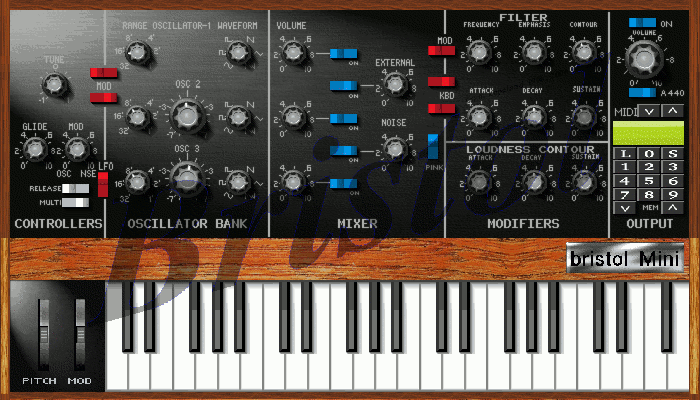|
CLever Audio Plug-in
CLever Audio Plug-in or CLAP is an open source software architecture, application programming interface and reference implementation suite for audio effect plugins as used in multimedia software such as digital audio workstations, audio editing software, and video editing software with integrated audio workflows. The specification and reference implementation was released in 2022 by the Berlin-based audio software companies u-he and Bitwig. CLAP was created as an open licensed alternative to proprietary audio plugin formats such as Steinberg's VST format, Apple's Audio Units format, or Avid Technology's ''Avid Audio Extension'' (AAX) format, designed for non-destructive parameter automation, multi-voice envelopes, true MIDI 2.0 support, better multi-core CPU performance and greater ease writing plugins in a non-proprietary licensing framework under the MIT License. CLAP is supported by 15 DAWs and 93 plugin producers who have produced 394 CLAP plugins. See also * LADSPA Th ... [...More Info...] [...Related Items...] OR: [Wikipedia] [Google] [Baidu] |
|
|
Apple Inc
Apple Inc. is an American multinational corporation and technology company headquartered in Cupertino, California, in Silicon Valley. It is best known for its consumer electronics, software, and services. Founded in 1976 as Apple Computer Company by Steve Jobs, Steve Wozniak and Ronald Wayne, the company was incorporated by Jobs and Wozniak as Apple Computer, Inc. the following year. It was renamed Apple Inc. in 2007 as the company had expanded its focus from computers to consumer electronics. Apple is the largest technology company by revenue, with billion in the 2024 fiscal year. The company was founded to produce and market Wozniak's Apple I personal computer. Its second computer, the Apple II, became a best seller as one of the first mass-produced microcomputers. Apple introduced the Lisa in 1983 and the Macintosh in 1984, as some of the first computers to use a graphical user interface and a mouse. By 1985, internal company problems led to Jobs leavin ... [...More Info...] [...Related Items...] OR: [Wikipedia] [Google] [Baidu] |
|
 |
Software Synthesizers
A software synthesizer or softsynth is a computer program that generates digital audio, usually for music. Computer software that can create sounds or music is not new, but advances in processing speed now allow softsynths to accomplish the same tasks that previously required the dedicated hardware of a conventional synthesizer. Softsynths may be readily interfaced with other music software such as music sequencers typically in the context of a digital audio workstation. Softsynths are usually less expensive and can be more portable than dedicated hardware. Types Softsynths can cover a range of synthesis methods, including subtractive synthesis (including analog modeling, a subtype), FM synthesis (including the similar phase distortion synthesis), physical modelling synthesis, additive synthesis (including the related resynthesis), and sample-based synthesis. Many popular hardware synthesizers are no longer manufactured but have been emulated in software. The emulation can ev ... [...More Info...] [...Related Items...] OR: [Wikipedia] [Google] [Baidu] |
 |
Music Software Plugin Architectures
Music is the arrangement of sound to create some combination of form, harmony, melody, rhythm, or otherwise expressive content. Music is generally agreed to be a cultural universal that is present in all human societies. Definitions of music vary widely in substance and approach. While scholars agree that music is defined by a small number of specific elements, there is no consensus as to what these necessary elements are. Music is often characterized as a highly versatile medium for expressing human creativity. Diverse activities are involved in the creation of music, and are often divided into categories of composition, improvisation, and performance. Music may be performed using a wide variety of musical instruments, including the human voice. It can also be composed, sequenced, or otherwise produced to be indirectly played mechanically or electronically, such as via a music box, barrel organ, or digital audio workstation software on a computer. Music often plays a key r ... [...More Info...] [...Related Items...] OR: [Wikipedia] [Google] [Baidu] |
 |
LADSPA
The Linux Audio Developer's Simple Plugin API (LADSPA) is an application programming interface (API) standard for handling audio filters and audio signal processing effects, licensed under LGPL-2.1-or-later. Originally designed through consensus on the Linux Audio Developers mailing list, it now works on a variety of platforms. It is used in many free audio software projects, and there is a wide range of LADSPA plug-ins available. LADSPA exists primarily as a header file written in the programming language C. There are many audio plugin standards and most major modern software synthesizers and sound editors support a variety. The best known standard is probably Steinberg's Virtual Studio Technology. LADSPA is unusual in that it attempts to provide only the "Greatest Common Divisor" of other standards. This means that its scope is limited, but it is simple and plugins written using it are easy to embed in many other programs. The standard has changed little with time, so compat ... [...More Info...] [...Related Items...] OR: [Wikipedia] [Google] [Baidu] |
|
Multi-core Processor
A multi-core processor (MCP) is a microprocessor on a single integrated circuit (IC) with two or more separate central processing units (CPUs), called ''cores'' to emphasize their multiplicity (for example, ''dual-core'' or ''quad-core''). Each core reads and executes Instruction set, program instructions, specifically ordinary Instruction set, CPU instructions (such as add, move data, and branch). However, the MCP can run instructions on separate cores at the same time, increasing overall speed for programs that support Multithreading (computer architecture), multithreading or other parallel computing techniques. Manufacturers typically integrate the cores onto a single IC Die (integrated circuit), die, known as a ''chip multiprocessor'' (CMP), or onto multiple dies in a single Chip carrier, chip package. As of 2024, the microprocessors used in almost all new personal computers are multi-core. A multi-core processor implements multiprocessing in a single physical package. Des ... [...More Info...] [...Related Items...] OR: [Wikipedia] [Google] [Baidu] |
|
 |
MIDI
Musical Instrument Digital Interface (; MIDI) is an American-Japanese technical standard that describes a communication protocol, digital interface, and electrical connectors that connect a wide variety of electronic musical instruments, computers, and related audio devices for playing, editing, and recording music. A single MIDI cable can carry up to sixteen channels of MIDI data, each of which can be routed to a separate device. Each interaction with a key, button, knob or slider is converted into a MIDI event, which specifies musical instructions, such as a note's pitch, timing and velocity. One common MIDI application is to play a MIDI keyboard or other controller and use it to trigger a digital sound module (which contains synthesized musical sounds) to generate sounds, which the audience hears produced by a keyboard amplifier. MIDI data can be transferred via MIDI or USB cable, or recorded to a sequencer or digital audio workstation to be edited or played back. ... [...More Info...] [...Related Items...] OR: [Wikipedia] [Google] [Baidu] |
 |
Envelope (music)
In sound and music, an envelope describes how a sound changes over time. For example, a piano key, when struck and held, creates a near-immediate initial sound which gradually decreases in volume to zero. An envelope may relate to elements such as amplitude (volume), frequency (with the use of filters) or pitch. Envelope generators, which allow users to control the different stages of a sound, are common features of synthesizers, samplers, and other electronic musical instruments. The most common envelope generator is controlled with four parameters: attack, decay, sustain and release (ADSR). Envelope generators Development The envelope generator was created by the American engineer Robert Moog, the creator of the Moog synthesizer, in the 1960s. The composer Herbert Deutsch suggested Moog find a way to articulate his synthesizer so notes did not simply trigger on and off. Moog wired a doorbell button to the synthesizer and used a capacitor to store and slowly release ... [...More Info...] [...Related Items...] OR: [Wikipedia] [Google] [Baidu] |
|
Avid Technology
Avid Technology, Inc. is a global technology company headquartered in Burlington, Massachusetts, and was founded in August 1987 by Bill Warner. It develops software, SaaS, and hardware products used in media and entertainment. History Avid was founded by Bill Warner, a former marketing manager from Apollo Computer. A prototype of their first non-linear editing system, the Avid/1 Media Composer, was shown at the National Association of Broadcasters (NAB) convention in April 1988. The Avid/1 was based on an Apple Macintosh II computer, with special hardware and software of Avid's design installed. The Avid/1 was "the biggest shake-up in editing since Melies played with time and sequences in the early 1900s". By the early 1990s, Avid products began to replace such tools as the Moviola, Steenbeck, and KEM flatbed editors, allowing editors to handle their film creations with greater ease. The first feature film edited using the Avid was ''Let's Kill All the Lawyers'' in 1992 ... [...More Info...] [...Related Items...] OR: [Wikipedia] [Google] [Baidu] |
|
|
Audio Units
Audio Units (AU) are a system-level Plug-in (computing), plug-in architecture provided by Core Audio in Apple Inc., Apple's macOS and iOS operating systems. Audio Units are a set of application programming interface (API) services provided by the operating system to generate, process, receive, or otherwise manipulate streams of audio in near-real-time with minimal latency. It may be thought of as Apple's architectural equivalent to another popular plug-in format, Steinberg's Virtual Studio Technology (VST). Because of the many similarities between Audio Units and VST, several commercial and free wrapping technologies are available (e.gSymbiosisand FXpansion]VST-AU Adapter. Celemony Software and PreSonus have also developed the Audio Random Access (ARA) extension, which works for both AU and Virtual Studio Technology, VST, allowing greater integration between the Audio plug-in, plug-ins and Digital audio workstation, DAW software. Use Audio Units allows sound file audio time s ... [...More Info...] [...Related Items...] OR: [Wikipedia] [Google] [Baidu] |
|
 |
Virtual Studio Technology
Virtual Studio Technology (VST) is an audio plug-in software interface that integrates software synthesizers and effects units into digital audio workstations. VST and similar technologies use digital signal processing to simulate traditional recording studio hardware in software. Thousands of plugins exist, both commercial and freeware, and many audio applications support VST under license from its creator, Steinberg. Overview VST plugins generally run within a digital audio workstation (DAW), to provide additional functionality, though a few standalone plugin hosts exist that support VST. Most VST plugins are either instruments (VSTi) or effects (VSTfx), although other categories exist—for example spectrum analyzers and various meters. VST plugins usually provide a custom graphical user interface that displays controls similar to physical switches and knobs on audio hardware. Some (often older) plugins rely on the host application for their user interface. VST instrumen ... [...More Info...] [...Related Items...] OR: [Wikipedia] [Google] [Baidu] |